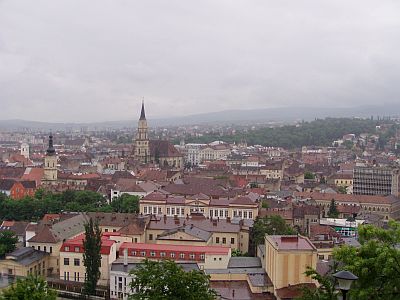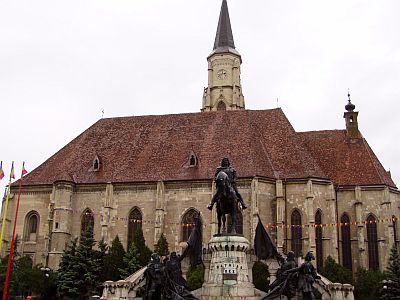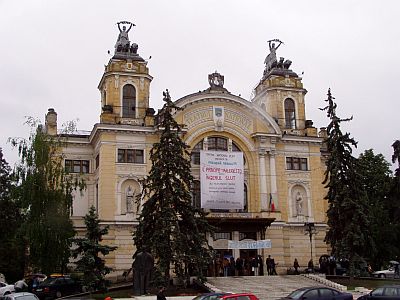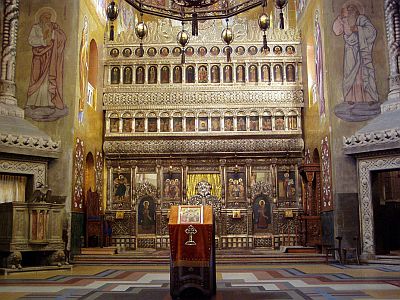|
|
|
|
|
|
 Name: Cluj-Napoca in Romania. However, most Romanians simply call the
town Cluj (pron: kloodsh). The second part Napoca
was the old Roman-Dacian name, which had been added to the Romanian name as a reminiscence of the long history.
Hungarians call the town Kolozsvár, to Germans it's known as Klausenburg
In the local German dialect, the name Kleusenburch was quite common.
In Roman times, the same town was known as Castrum Clus (the German name is a
translation of this word) and Claudiopolis.
Location:
In the northern part of Transylvania and more than 300 km north-west of
→Bucharest as the crow flies. Cluj stretches along the foot of the
Apuseni Mountains and straddles the small river Someşul Mic.
Population: some 330,000 inhabitants. Cluj is the fifth-largest
town of Romania and by far the largest town in Transylvania. There's a remarkably large Hungarian minority in town.
Orientation:
The small river Someşul Mic flows from south-west to north-east, cutting the town
in two parts. The historic centre of town can be found in the south-eastern part, starting right at the river.
The main train station is more than one kilometre away from the old town to the north.
The station and the centre are connected by the wide Str. Horea. When you walk
from the station direction old town and turn right before the bridge, you will notice a large hill with an ugly hotel
on the top of it. Around the hotel you will find the remainings of an old fortress, but there's not much left of it.
Name: Cluj-Napoca in Romania. However, most Romanians simply call the
town Cluj (pron: kloodsh). The second part Napoca
was the old Roman-Dacian name, which had been added to the Romanian name as a reminiscence of the long history.
Hungarians call the town Kolozsvár, to Germans it's known as Klausenburg
In the local German dialect, the name Kleusenburch was quite common.
In Roman times, the same town was known as Castrum Clus (the German name is a
translation of this word) and Claudiopolis.
Location:
In the northern part of Transylvania and more than 300 km north-west of
→Bucharest as the crow flies. Cluj stretches along the foot of the
Apuseni Mountains and straddles the small river Someşul Mic.
Population: some 330,000 inhabitants. Cluj is the fifth-largest
town of Romania and by far the largest town in Transylvania. There's a remarkably large Hungarian minority in town.
Orientation:
The small river Someşul Mic flows from south-west to north-east, cutting the town
in two parts. The historic centre of town can be found in the south-eastern part, starting right at the river.
The main train station is more than one kilometre away from the old town to the north.
The station and the centre are connected by the wide Str. Horea. When you walk
from the station direction old town and turn right before the bridge, you will notice a large hill with an ugly hotel
on the top of it. Around the hotel you will find the remainings of an old fortress, but there's not much left of it.
There's no compact, homogeneous old town centre - instead of that, it's a blend of
modern (but not really interesting) and old architecture. The centre covers
a rather wide area, but still it's all within walking distance.
Getting there:
Cluj is the major transport hub in the area, and so there are many train connections.
Some daily fast and less fast trains run to →Iaşi (9 hrs,
315,000 Lei for the Acc.), →Braşov,
→Bucharest, →Oradea (2½ to 5 hrs,
83'000 Lei for the local train) etc. In Cluj, the tram is the best way to get around.
|
|
|
|
|
|
|
Cluj is a very old centre - it first appeared in chronicles of the year 124 AD and was known as Napoca than.
It was even called a colony, which means that it was quite a big town. The fact that Cluj developed well also during the Middle Ages mainly owes to
its location at the crossroads of important trade routes. During the 12th century, first German merchants settled in Cluj aka Klausenburg.
Starting in the 18th century, Cluj even became the capital of Transylvania for a long time. The entire area eventually became a part of
Hungary in 1867. In 1940, Cluj and the rest of Northern Transylvania was annexed by Hungary again after a long period of independence.
During the following years, the Hungarian occupants commited several atrocities against the Romanian population.
Nowadays, Cluj is an important unversity town with rather drab suburbs and an old town centre in transition.

| |
A view from the fortress over the town centre
|
Climbing the hill with the Cetăţuie (Citadel) on the top of it is well worth the effort,
since it provides a lovely view over the whole centre of town including the river and some new, modern buildings opposite the
fortress. The façades of the new buildings are completely made of coloured glass resembling booming Chinese provincial towns.
The fortress itself consists of not much more than some crumbling walls. Instead of old towers there's an ugly concrete
structure housing a rather expensive hotel. The citadel is surrounded by a lovely park.

| |
St Michael Church on Piaţa Unirii
|
The old town is clearly dominated by Biserica Sfaântul Mihail (St Michael Church). This fine Gothic
church was completed in the 15th century and stands in the middle of central
Piaţa Unirii (Union Square). The neo-Gothic tower of the church was added much later, in 1859 to be
exactly, and is by far the tallest structure in the city (as it can be seen on the panorama above)
In front of the church there's a large monument with the inscription Mathias Rex (King Mathew),
created in 1902 and dedicated to the legendary king of →Hungary. His name was
Mátyás Corvinus and he ruled the Hungarian empire from 1458 to 1490. The original inscription read
"Hungariae Mathias Rex", but the ultra-nationalist mayor of Cluj let the word "Hungariae" remove. What an idiocy -
removing the word 'Hungariae' doesn't make him a Romanian king! Furthermore, the same mayor let workers open a pit in front
of the monument to keep the visitors away. The pit is gone and so is the mayor - his resignation was met with headlines
such as 'Welcome back to Europe, Cluj' by some newspapers. At the same square and in the vicinity you will find a handful of museums,
but all of them seem to be closed on Mondays.

| |
The National Theatre of Cluj
|
Starting from the southern edge of Union Square, Blvd. Eroilor runs eastwards and leads straight to another two
squares facing each other - the one to the right is the Piaţa Ştefan cel Mare (Stephen the Great Square),
the other one to the left Piaţa Avram Iancu (Iancu Square). The former is marked by the
beautiful Teatrul National (see picture). There's another theatre in town - the Hungarian National Theatre at the river.
There are only two Hungarian theatres in Romania. And there were only two buildings in Cluj where announcements written in Hungarian
were allowed. But this hopefully changed by the time you read this - as mentioned above, the ultra-nationalist mayor has gone.

| |
The beautiful Iconostas inside the Orthodox Cathedral
|
Opposite the National Theatre and in the centre of large Avram Iancu Square,
there's the Orthodox Cathedral of Cluj-Napoca. The church is impressive from the outside as well
as from the inside. What else to see in Cluj? Churches, synagogues, some museums... All in all it's well worth to
stay a day or so in Cluj. However, the town can't offer an atmosphere as for example →Braşov or
→Sighetu Marmaţiei.
|
|
|
|
|
|
|
The mountains are not far. Around 30 km south-west of Cluj, there's the famous Turda Gorge with
a spectacular landscape and some old salt mines. Aorund Cluj, especially in the north-east, there are many traditional villages.
|
|
|
|
|
|
|
Cluj has many visitors and therefore many hotels. Some of them are in the centre of town, others close to the train station.
Among the latter, there's the Hotel Pax. Just step out of the train station, cross the street and
you will already stand in front of the entrance. Rooms are small but clean, with shared bath and toilet but including breakfast.
The price per person is 400,000 Lei (€ 10) in a double. Address: Piaţa Gării 1-3, Tel.: (064)-136 101.
There are plenty of restaurants in town. One of the better restaurants is called Gente Senior at Str. Horea 5:
The front room of the restaurant is a pizzeria, the rooms behind turn out to be a fine Romanian restaurant with good quality food for a
reasonable price (main dishes are around 100,000 Lei (€ 2.5).
Restaurant Unic is substantially cheaper - traditional Romanian dishes cost around € 1. The restaurant is
located in the middle of above-mentioned Bulevardul Eroilor.
Next to Restaurant Gente there's the Music Pub - a large cellar which seems to be popular with students.
The pub offers good music and good drinks for a handful of Lei.
|
|
|
|
|
|
|
www.primariaclujnapoca.ro/eng/
English version of an extensive website about Cluj.
www.virtualtourist.com/m/eca9/7ebff
Personal website of a citizen of Cluj-Napoca with pictures and in English.
www.clujnapoca.ro
Is this the official website of Cluj? I'm not sure. Anyway, it's rather poor.
Do you have or do you know a good website about Cluj-Napoca? Don't hesitate, let me know!
After checking it, I would love to add it to the link list.
Please note that commercial websites will be declined. For e-mail link see menu on the left.
|
|
| |




